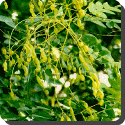 Japanese Pagoda Tree — Styphnolobium is a small genus of three or four species of small trees and shrubs in the subfamily Faboideae of the pea family Fabaceae, formerly included within a broader interpretation of the genus Sophora. The species of Styphnolobium differ from Sophora in lacking the ability to form symbioses with rhizobia (nitrogen fixing bacteria) on their roots. They also differ from the related genus Calia (mescalbeans) in having deciduous leaves and flowers in axillary, not terminal, racemes. The leaves are pinnate, with 9-21 leaflets, and the flowers in pendulous racemes similar to those of the Black locust.
Japanese Pagoda Tree — Styphnolobium is a small genus of three or four species of small trees and shrubs in the subfamily Faboideae of the pea family Fabaceae, formerly included within a broader interpretation of the genus Sophora. The species of Styphnolobium differ from Sophora in lacking the ability to form symbioses with rhizobia (nitrogen fixing bacteria) on their roots. They also differ from the related genus Calia (mescalbeans) in having deciduous leaves and flowers in axillary, not terminal, racemes. The leaves are pinnate, with 9-21 leaflets, and the flowers in pendulous racemes similar to those of the Black locust.
The Pagoda Tree is widely used in bonsai gardening. The Guilty Chinese Scholartree was a historic Pagoda Tree in Beijing, on which the last emperor of the Ming Dynasty, Chongzhen, hanged himself.
Despite its name, the Japanese pagoda tree, Sophora japonica, is native to China and Korea. It is a member of the pea family, Leguminosae, and grows to 24 m (80 ft) high. Its leaves, which are shed in the fall, are divided into three to eight pairs of leaflets.
 Kids Portal For Parents India Kids Network
Kids Portal For Parents India Kids Network






